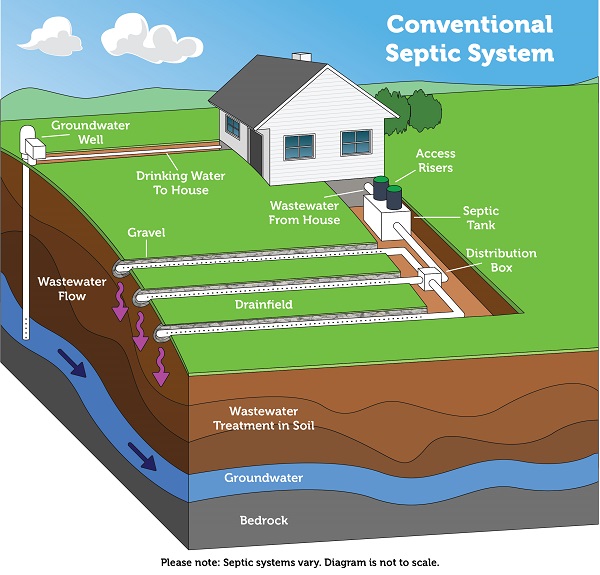
by Andrea Albertin | Apr 1, 2022
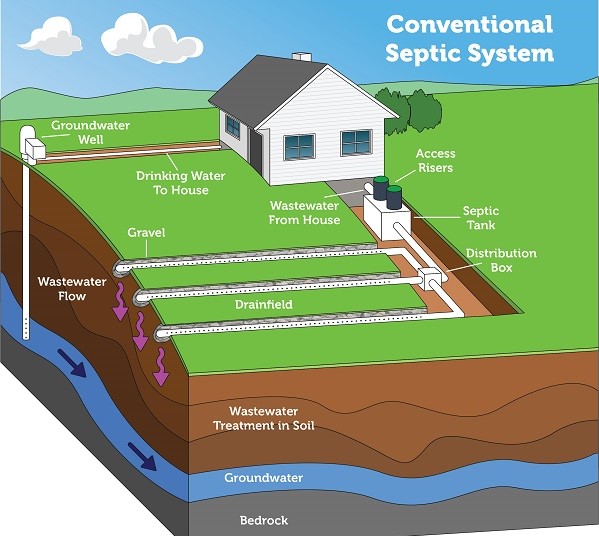
A conventional septic system is composed of a septic tank and a drainfield, where most of the wastewater treatment takes place. Image: US EPA
Why do you need to maintain a septic system?
Conventional septic systems are made up of a septic tank (a watertight container buried in the ground) and a drain field, or leach field. In the septic tank, solids settle on the bottom (the sludge layer), and oils and grease float to the top and form a scum layer. The liquid wastewater, which is in the middle layer of the tank, flows out through perforated pipes into the drainfield, where it percolates down through the ground. Most wastewater treatment takes place in the drainfield.
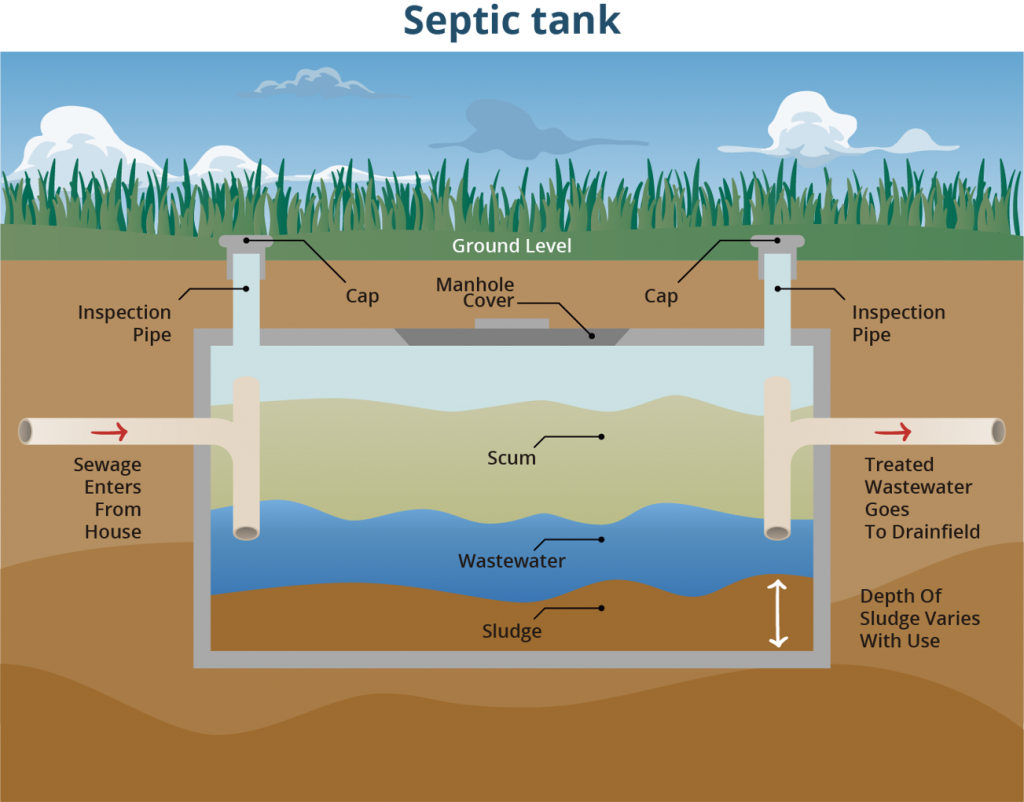
Solids settle to the bottom of a septic tank (sludge), oils and greases float to the top (scum) and wastewater (effluent) flows out of the tank into the drainfield for further treatment. Image: Soil and Water Science Lab, UF GREC.
Although bacteria continually work on breaking down the organic matter in your septic tank, sludge and scum will build up, which is why a system needs to be cleaned out periodically. If not, sludge and scum can flow into the drainfield clogging the pipes and sewage can back up into your house. Overloading the system with water also reduces its ability to work properly by not leaving enough time for material to separate out in the tank, and by flooding the system.
Should you use additives in your septic system?
Septic systems do not need any additives to function properly and treat wastewater. Although there are many commercial microbiological and enzyme additives sold on the market that claim to enhance bacterial populations and reduce the time between septic system pumping, there really isn’t any peer-reviewed scientific literature that shows that these additives are effective in doing what they claim.
In Florida, the Department of Health (DOH) reviews commercially sold additives to ensure that they are safe to use in septic systems. DOH clearly states that although products are approved, it does not mean that this is an endorsement or a product recommendation. Approval simply means that as required by Florida law, the additive doesn’t interfere with septic system function and that when an additive is used, the effluent (wastewater) leaving the septic system meets Florida’s water quality standards. Only products in compliance with this law can be sold or used in septic systems in Florida. You can find a list of approved products and more information regarding additives on the Florida Department of Environmental Protection (FDEP) septic system website. Access the list of products directly here (updated 10/18/2021).
How can you properly care for your septic system?
The best way to keep your system functioning properly is to follow some common-sense practices.
- Only flush human waste and toilet paper down the toilet. Wet wipes do not break down in the septic system even though the packaging labels them as septic-safe!
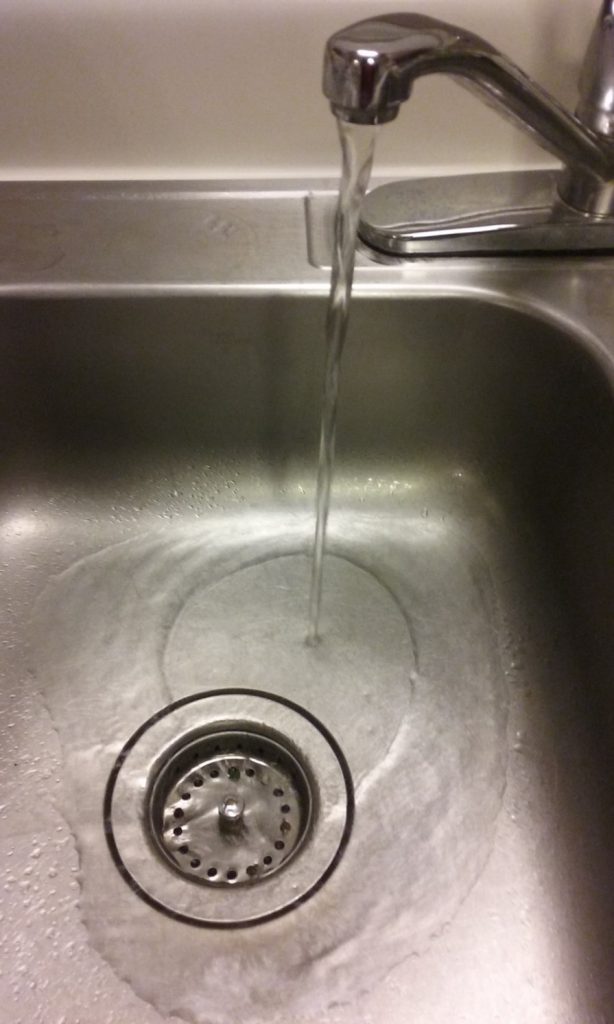
Be mindful of what you put down sinks and flush down toilets. All drains in your home lead to the septic tank. Image: A. Albertin
- Think at the sink. Avoid pouring oil and fat down the kitchen drain. Avoid excessive use of harsh cleaning products and detergents which can affect the microbes in your septic tank (regular weekly cleaning is fine). Prescription drugs and antibiotics should never be flushed down the toilet.
- Limit your use of the garbage disposal. Disposals add organic matter and additional water to your septic system, which results in the need for more frequent pumping.
- Take care at the surface of your tank and drainfield. Don’t drive vehicles or heavy equipment over the system. Avoid planting trees or shrubs with deep roots that could disrupt the system or plug pipes.
- Conserve water. Reduce the amount of water pumped into your septic tank through water conservation practices like (1) repairing leaky faucets, toilets, and pipes, (2) installing, low-flush toilets, low-flow showerheads and faucet aerators, and (3) only running the washing machine and dishwasher when full.
- Have your septic system pumped by a certified professional. The general rule of thumb is every 3-5 years, but it will depend on household size, the size of your septic tank, how much wastewater you produce and what you flush down your toilet.
Even when conventional septic systems are well maintained, they are still a source of nutrients, particularly nitrogen, to groundwater. They were designed from a public health perspective to remove pathogens, not nutrients.
For more information on septic systems, visit the UF/IFAS septic system website and FDEP’s septic system website.

by Andrea Albertin | Jun 3, 2017
The Florida Panhandle received much needed rain this week, helping to alleviate dry conditions in many areas of the region. However, drought conditions persist in the rest of Florida. According to the US Drought Monitor drought conditions range from moderate in north central Florida to dire in the south-central portion of the state. Precipitation is at 25- 50% of normal rates in the Orlando region. In response, city and county governments and Water Management Districts in these areas are increasing restrictions on outdoor residential water use. In homes with irrigation systems, 50% of the water consumed is typically used for irrigation.
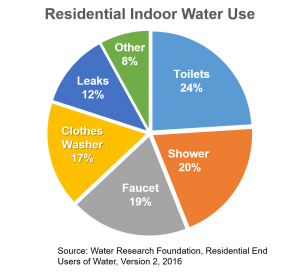
Indoors, we can all greatly reduce water use by adopting relatively simple conservation practices. In a typical household, flushing toilets consumes the most water (24%), followed by showers (20%), faucets (19%), the clothes washer (17%) and leaks (8%) (Source: 2016 report by the Water Research Foundation).
- Consider replacing toilets installed before 1994 with new ones. Pre-1994, toilets used between 3.5 to 7 gallons per flush. From 1994 to date, regulations require toilets to use a maximum of 1.6 gallons per flush and some use as little as 1.28 to 0.8 gallons per flush.
- Placing an object in your toilet tank (like a filled plastic bottle or a brick or two) reduces the amount of water needed to fill the tank and is an inexpensive alternative to replacing a toilet.
- Reduce the amount of time you take per shower, and replace showerheads with low-flow models, which deliver 0.5 – 2.0 gallons per minute. Standard shower heads use 2.5 gallons per minute. Low flow models typically range from $10 to $30.
- Placing a faucet aerator on the end of a faucet can reduce water used from 2.2 gallons/minute to 1.5 gallons per minute. Costs typically range from as low as $5 to $15 each.
- Run the washing machine and dishwasher only when they are full.
- Check for leaks in plumbing and appliances (and fix them!). You can check for toilet leaks by placing food coloring in the tank and seeing if the dye appears in the toilet bowl.
Conserving water at home has the double benefit of reducing your water bill and your energy bill since the amount of energy used to heat water and run the dishwasher and washer/dryer are reduced.
The Southwest Florida Water Management District provides an excellent, easy-to-use online Water Use Calculator, which you can access by going to https://www.swfwmd.state.fl.us/conservation/thepowerof10/. You can calculate your approximate current water use, and compare that to how many gallons your household could save by changing specific habits (like reducing shower times), reducing outdoor irrigation times and upgrading fixtures and appliances.
The US Drought Monitor can be accessed at http://droughtmonitor.unl.edu/Home.aspx

by Andrea Albertin | Apr 29, 2017
One third of homes in Florida rely on septic systems, or onsite sewage treatment and disposal systems (OSTDS), to treat and dispose of household wastewater, which includes wastewater from bathrooms, kitchen sinks and laundry machines. When properly maintained, septic systems can last 25-30 years, and maintenance costs are relatively low.
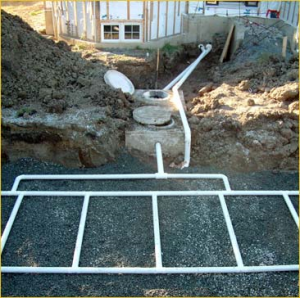
A conventional residential septic tank and drain field under construction.
Photo: Andrea Albertin
A general rule of thumb is that with proper care, systems need to be pumped every 3-5 years at a cost of about $300 to $400. Time between pumping does vary though, depending on the size of your household, the size of your septic tank and how much wastewater you produce. If systems aren’t maintained they can fail, and repairs or replacing a tank can cost anywhere between $3000 to $10,000. It definitely pays off to maintain your septic system!
The most common type of OSTDS is a conventional septic system, which is made up of a septic tank (a watertight container buried in the ground) and a drain field, or leach field. The septic tank’s job is to separate out solids (which settle on the bottom as sludge), from oils and grease, which float to the top and form a scum layer. The liquid wastewater, which is in the middle layer of the tank, flows out through pipes into the drainfield, where it percolates down through the ground.
Although bacteria continually work on breaking down the organic matter in your septic tank, sludge and scum will build up, which is why a system needs to be cleaned out periodically. If not, solids will flow into the drainfield clogging the pipes and sewage can back up into your house. Overloading the system with water also reduces its ability to work properly by not leaving enough time for material to separate out in the tank, and by flooding the system. Sewage can flow to the surface of your lawn and/or back up into your house.
Failed septic systems not only result in soggy lawns and horrible smells, but they contaminate groundwater, private and public supply wells, creeks, rivers and many of our estuaries and coastal areas with excess nutrients, like nitrogen, and harmful pathogens, like E. coli.
It is important to note that even when traditional septic systems are maintained, they are still a source of nitrogen to groundwater; nitrate is not fully removed from the wastewater effluent.
How can you properly care for your septic system?
Here are a some basic tips to keep your system working properly so that you can reduce maintenance costs by avoiding system failure, and so that you can reduce your household’s impact on water pollution in your area.
- Don’t flush trash down the toilet. Only flush regular toilet paper. Toilet paper treated with lotion forms a layer of scum. Wet wipes are not flushable, although many brands are labelled as such. They wreak havoc on septic systems! Avoid flushing cigarette butts, paper towels and facial tissues, which can take longer to break down than toilet paper.
- Think at the sink. Avoid pouring oil and fat down the kitchen drain. Avoid excessive use of harsh cleaning products and detergents, which can affect the microbes in your septic tank (regular weekly or so cleaning is fine). Prescription drugs and antibiotics should never be flushed down the toilet.
- Limit your use of the garbage disposal. Disposals add organic matter to your septic system, which results in the need for more frequent pumping. Composting is a great way to dispose of your fruit and vegetable scraps instead.
- Take care at the surface of yourtank and drainfield. To work well, a septic system should be surrounded by non-compacted soil. Don’t drive vehicles or heavy equipment over the system. Avoid planting trees or shrubs with deep roots that could disrupt the system or plug pipes. It is a good idea to grow grass over the drainfield to stabilize soil and absorb liquid and nutrients.
- Conserve water. You can reduce the amount of water pumped into your septic tank by reducing the amount you and your family use. Water conservation practices include repairing leaky faucets, toilets and pipes, installing low cost, low-flow showerheads and faucet aerators, and only running the washing machine and dishwasher when full. In the US, most of the household water used is to flush toilets (about 27%). Placing filled water bottles in the toilet tank is an inexpensive way to reduce the amount of water used per flush.
- Have your septic system pumped by a certified professional. The general rule of thumb is every 3-5 years, but it will depend on household size, the size of your septic tank and how much wastewater you produce.
By following these guidelines, you can contribute to the health of your family, community and environment, as well as avoid costly repairs and septic system replacements.
You can find excellent information on septic systems a the US EPA website: https://www.epa.gov/septic. The Florida Department of Health website provides permiting information for Florida and a list of certified maintenance entities by county: http://www.floridahealth.gov/Environmental-Health/onsite-sewage/index.html.
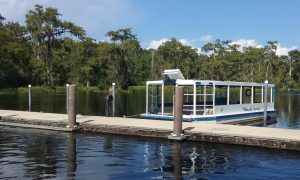
The Department of Environmental Protection (FDEP) identified septic systems as the major source of nitrate in Wakulla Springs, located in Wakulla County. Excess nitrate is thought to promote algal growth, leading to the degradation of the biological community in the spring.
Photo: Andrea Albertin
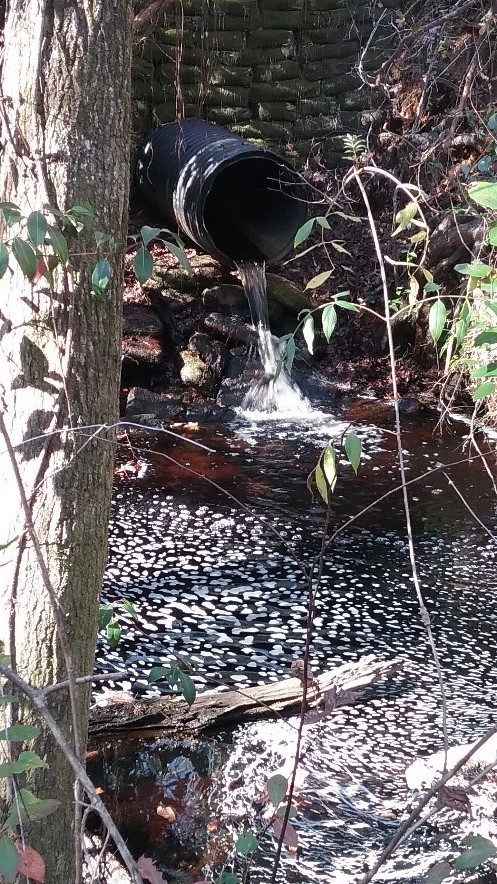
by Andrea Albertin | Mar 11, 2017
Stormwater runoff is water from rainfall that flows along the land surface. This runoff usually finds its way into the nearest ditch or water body, such as a river, stream, lake or pond. Generally speaking, in natural undeveloped areas only 10% of rainfall is runoff. About 40% returns to the atmosphere though evapotranspiration, which is the water evaporated from land and plant surfaces plus water lost directly from plants to the atmosphere through their leaves. The remaining 50% of rainfall soaks into the ground, supporting vegetation, contributing to streamflow and replenishing groundwater resources. In Florida, where 90% of the population relies on groundwater for their drinking water, aquifer recharge from infiltrating rainwater is vital.
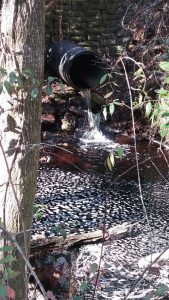
Stormwater runoff from a drainage pipe flowing into a creek.
Photo: Andrea Albertin
As landscapes become more developed, areas that use to absorb rainwater are replaced by impervious surfaces like rooftops, driveways, parking lots and roads. Additionally, we are levelling our land, removing natural depressions in the landscape that trap rainwater and give it time to seep back into the ground. As a result, a higher percentage of rainfall is becoming runoff and which flow at faster rates into storm drainages and nearby water bodies instead of soaking into the soil.
A major problem with stormwater runoff is that as it flows over surfaces, it picks up potential pollutants that end up in our waterways. These include trash, sediment, fertilizer and pesticides from lawns, bacteria from dog waste, metals from rooftops, and oil from parking lots and roads. Stormwater runoff is often the main cause of surface water pollution in urban areas.
Luckily, there are ways in which we can all help slow the flow and reduce stormwater runoff. These reductions can give rainfall more time to soak back into the ground and replenish our needed stores of groundwater.
What can you do to help “slow the flow” of stormwater?
The UF/IFAS Florida Friendly Landscaping Program provides the following recommendations that you, as a homeowner, can do to reduce stormwater runoff from your property:
- Direct your downspouts and gutters to drain onto the lawn, plant beds, or containment areas, so that rain soaks into the soil instead of running off the yard.
- Use mulch, bricks, flagstone, gravel, or other porous surfaces for walkways, patios, and drives.
- Reduce soil erosion by planting groundcovers on exposed soil such as under trees or on steep slopes
- Collect and store runoff from your roof in a rain barrel or cistern.
- Create swales (low areas), rain gardens or terracing on your property to catch, hold, and filter stormwater.
- Pick up after your pets.
- Clean up oil spills and leaks on the driveway. Instead of using soap and water, spread cat litter over oil, sweep it up and then throw away in the trash.
- Sweep grass clippings, fertilizer, and soil from driveways and streets back onto the lawn. Remove trash from street gutters before it washes into storm drains. The City of Tallahassee’s TAPP (Think About Personal Pollution) Campaign is another excellent resource for ways in which you can help reduce stormwater runoff (http://www.tappwater.org/).
- For more information on stormwater management on your property and other Florida Friendly Landscaping principles, you can visit the Florida Friendly Landscaping website at: https://ffl.ifas.ufl.edu.
TAPP also provides a manual for homeowners on how to build a raingarden, which can be found at http://tappwaterapp.com/what-can-i-do/build-a-rain-garden/. Raingardens are small depressions (either naturally occurring or created) that are planted with native plants. They are designed to temporarily catch rainwater, giving it time to slowly soak back into the ground.
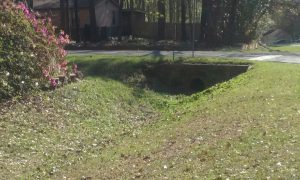
Grass covered drainage ditches slow the flow of stormwater runoff and allow more rainwater to soak back into the ground.
Photo: Andrea Albertin
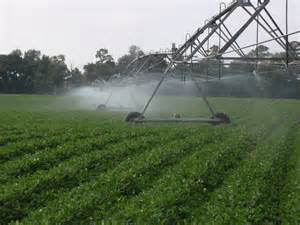
by Rick O'Connor | Jul 31, 2016
On a recent camping trip out west I was made aware of just how valuable water is. The American west has been battling water issues for a few years now. Some camp showers had buttons that would provide you water for a couple of minutes, others charged $.50 for four minutes, some charged $1.00 for four minutes. Not one campsite had water available at the site. You had to walk, load your container, and return. This forced you to be a little wiser on how you used it. You did not want to have to go back and get more very often.
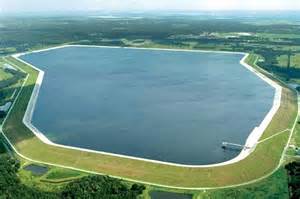
The Bill Young Reservoir in south Florida.
Photo: Southwest Florida Water Management District
However, I was troubled by some of the things I saw as I traveled through the southwest. Areas in the desert where farmers were trying to grow row crops, citrus, and pecans – irrigation systems set up everywhere, reservoirs with canals and dikes to feed much needed water to the farmers… and signs in town where you could buy water to drink at $.25/gallon. It seemed an inefficient use of this resource. It would make more sense to grow crops that used less water, maybe… no water. Recently we have heard a lot about “water wars” and “water rights” in the American southwest. Farmers seeking more, municipalities trying to grab their piece of the pie, football fields and golf courses, and even camp grounds. Some locations you cannot wash your car, or your dogs. It is a real dilemma they are facing. There were numerous creeks and streams I drove over that were absolutely dry, cattle in open rangeland seeking anywhere to find something to drink.
Could this happen in Northwest Florida?
You would think not. In the book Mirage by Cynthia Barnett, it mentions a comment made by Major John Wesley Powell. Major Powell was an ex-confederate officer who was hired by the U.S. Geological Survey to survey land across the south and to the southwest after the Civil War. He mentions problems with developing the American southwest primarily due to the lack of water… but water was something that Florida would never have to worry about – the state was saturated. And yet here we are… 150 years later discussing water rights in Florida. Currently it does not appear to be an issue. At any campground in Florida you will find a water source at each site and you can take a shower as long as you like – at no charge. We are one of the most productive agricultural states in the country – producing row crops, citrus, and cattle. Most in our communities have manicured watered lawns and many have swimming pools. There does not seem to be a problem here. BUT, many communities are beginning to see problems. Salt water intrusion into the water supply, lowering of the water table and aquifers, and even some streams running low. Could we… Florida… the land of water… be heading towards a “water war”?

This is a common method used to irrigate crops across the U.S.
Photo: UF IFAS
The University of Florida Extension Program has recently hired water management specialists in districts across the state. They will be looking at issues that include water quantity and quality to address the needs of each region. These specialists, along with the county faculty, will be working with local residents to discuss the local issues and help mitigate problems that could be looming on the horizon. We encourage all residents to consider how to better manage their water. Think in terms as if you had a set amount each month – budget this to meet your needs – and stick to your budget. Hopefully with research, education, and insight, we can avoid a true “Water War”.














